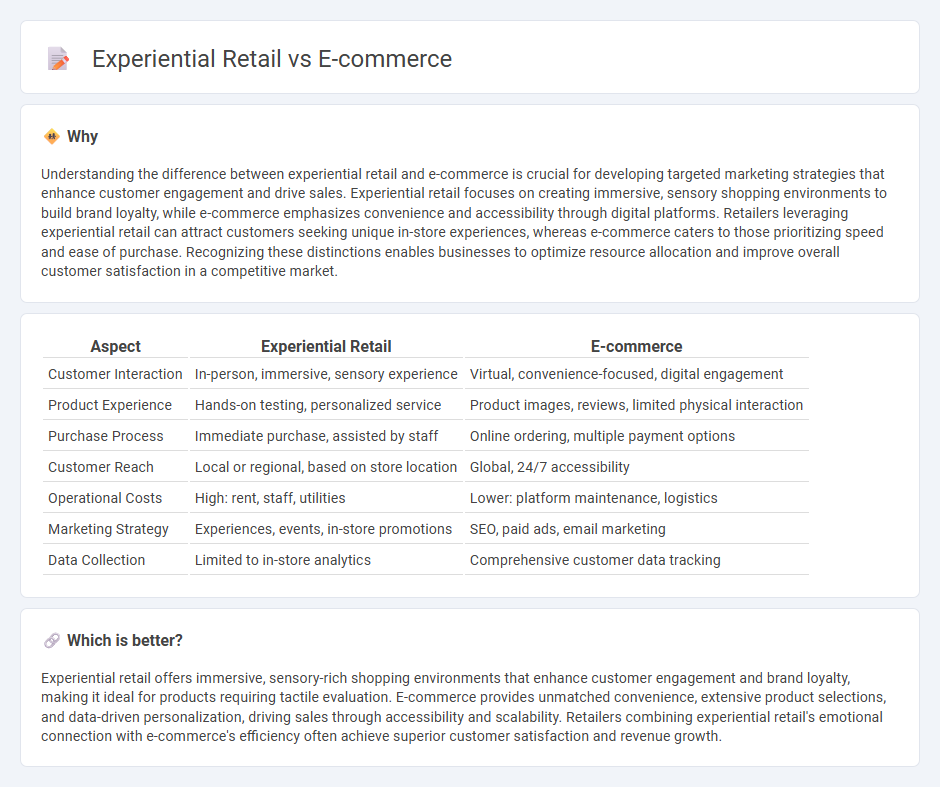
Experiential retail transforms traditional shopping by creating immersive, sensory-rich environments that engage customers beyond mere transactions, fostering brand loyalty and memorable interactions. E-commerce leverages digital platforms to offer convenience, broad product selection, and personalized recommendations, catering to the growing demand for online shopping. Explore the evolving dynamics between experiential retail and e-commerce to understand how businesses optimize customer experiences and drive growth.
Why it is important
Understanding the difference between experiential retail and e-commerce is crucial for developing targeted marketing strategies that enhance customer engagement and drive sales. Experiential retail focuses on creating immersive, sensory shopping environments to build brand loyalty, while e-commerce emphasizes convenience and accessibility through digital platforms. Retailers leveraging experiential retail can attract customers seeking unique in-store experiences, whereas e-commerce caters to those prioritizing speed and ease of purchase. Recognizing these distinctions enables businesses to optimize resource allocation and improve overall customer satisfaction in a competitive market.
Comparison Table
| Aspect | Experiential Retail | E-commerce |
|---|---|---|
| Customer Interaction | In-person, immersive, sensory experience | Virtual, convenience-focused, digital engagement |
| Product Experience | Hands-on testing, personalized service | Product images, reviews, limited physical interaction |
| Purchase Process | Immediate purchase, assisted by staff | Online ordering, multiple payment options |
| Customer Reach | Local or regional, based on store location | Global, 24/7 accessibility |
| Operational Costs | High: rent, staff, utilities | Lower: platform maintenance, logistics |
| Marketing Strategy | Experiences, events, in-store promotions | SEO, paid ads, email marketing |
| Data Collection | Limited to in-store analytics | Comprehensive customer data tracking |
Which is better?
Experiential retail offers immersive, sensory-rich shopping environments that enhance customer engagement and brand loyalty, making it ideal for products requiring tactile evaluation. E-commerce provides unmatched convenience, extensive product selections, and data-driven personalization, driving sales through accessibility and scalability. Retailers combining experiential retail's emotional connection with e-commerce's efficiency often achieve superior customer satisfaction and revenue growth.
Connection
Experiential retail enhances customer engagement by creating immersive in-store experiences that complement the convenience of e-commerce platforms, driving both online and offline sales. Integrating technologies such as augmented reality and personalized digital interfaces bridges physical and digital shopping, increasing consumer interaction and brand loyalty. Data-driven insights from e-commerce behavior inform experiential retail strategies, optimizing inventory and marketing efforts for a seamless omnichannel experience.
Key Terms
Omnichannel
E-commerce leverages digital platforms to offer convenience, vast product selections, and personalized recommendations through data-driven strategies. Experiential retail emphasizes immersive in-store experiences, blending physical interaction with digital touchpoints to foster brand loyalty and customer engagement. Explore how omnichannel integration combines the strengths of both to deliver seamless shopping journeys across online and offline channels.
Personalization
E-commerce platforms leverage AI-driven algorithms to offer highly personalized product recommendations and customized shopping experiences based on user behavior and preferences. Experiential retail emphasizes immersive, sensory-rich environments that cater to individual tastes through interactive displays and personalized customer service, creating emotional connections. Discover how integrating both strategies can elevate personalization and enhance customer loyalty.
In-store engagement
In-store engagement thrives in experiential retail by creating immersive, sensory-rich environments that encourage direct interaction with products and personalized customer service, leading to higher brand loyalty and memorable shopping experiences. E-commerce predominantly relies on digital tools like AI-driven recommendations, virtual try-ons, and interactive content to simulate engagement, yet often lacks the tactile and social elements inherent to physical stores. Explore how integrating both strategies can maximize customer engagement and drive sales growth.
Source and External Links
What Is Ecommerce? Guide To Selling Online (2025) - Ecommerce is the buying and selling of goods and services over the internet, involving transactions between businesses and consumers, individuals, or other entities, including several models such as direct-to-consumer, business-to-business, and consumer-to-consumer commerce.
Ecommerce (Learn About the Evolution of Online Shopping) - Ecommerce encompasses various business models including B2C (business-to-consumer), B2B (business-to-business), and C2C (consumer-to-consumer), enabling rapid scaling and streamlining through technology and automation.
Glossary:E-commerce - Statistics Explained - Eurostat - E-commerce is defined as the sale or purchase of goods or services via electronic networks, generally the internet, including activities such as buying financial investments, confirming travel reservations, and buying via online auctions.
 dowidth.com
dowidth.com